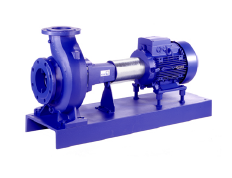By Djordje Mitrovic
Fig. 1a Pressure reduction valve (BERMAD, n.d.)
Some level of water loss occurs in water distribution networks during its operational lifetime no matter how well these are managed. For perspective, on the level of EU the values of water losses span from single digit values in Germany, Denmark and Netherlands up to around 45% in Ireland, with an average of 23% (The European Federation of National Water Services, 2017). As the relationship between the leakage and pressure has been well established, in the last 30 years, many pressure reduction valves (PRVs) have been deployed within WDNs around the world for pressure management purposes. In the United Kingdom some of the main water utilities operate in the range of 2,000 districted meter areas, where 50%–60% are pressure managed using PRVs (Vicente et al., 2016).
Fig. 1b Pump as turbine (KSB, 2020)
Nevertheless, the energy dissipated at PRVs is lost. Aiming to improve the energy efficiency of WDNs, since the beginning of the last decade researchers have started to explore the technological and economic feasibility of replacing these valves with different kinds of hydroelectric converters (Mc Nabola et al., 2011). So called pumps as turbines (or just PATs) have been pointed out as the most suitable technology for this purpose because of their lower cost for the sites with lower installation capacities (< 100kW) such as the ones occurring at PRVs within WDNs (Novara et al., 2019).
An upgrade of a PRV to a PAT based pressure reduction station is usually considered economically viable investment if the revenue generated by selling the electricity to the grid pays it back in less than 10 years or if its net present value (NPV) is positive 10 years after the investment (Fernández García et al., 2019).
A recent study from the literature carried out by Mitrovic et al. (2022) investigated the research question from the title. The authors argued that for two PRV sites of the similar average operating conditions, the uncertainties that can make a difference so that one is economically viable and the other not, are: variations of the operating conditions (flow and pressure), variations of total installations cost and electricity unit price. Finally, the results of the study showed that the calculated upper bound of economic viability (the most unfavorable scenario) coincides with a curve representing constant gross hydraulic power () of 12kW (see Fig. 2). In other words, the results implied that it is reasonable to expect that regardless of the uncertainty related to the variation of hydraulic parameters and the costs, that PRV sites possessing the gross hydraulic power higher than 12 kW should be economically viable for the upgrade.
Fig. 2: Bound of economically viable sites as a function of CR and ‖QH‖_2 . With CR – Ratio between the cost of PAT+generator assembly and total installation costs; ‖QH‖_2 – a variable quantifying the level of variation of flow and pressure at PRV sites.
References
BERMAD, n.d. Water Control Solutions - Bermad [WWW Document]. URL https://www.bermad.com/ (accessed 1.28.21).
Fernández García, I., Novara, D., Nabola, A.M., García, I.F., Novara, D., Nabola, A.M., 2019. "A model for selecting the most cost-effective pressure control device for more sustainable water supply networks". Water (Switzerland) 11. https://doi.org/10.3390/w11061297
KSB, 2020. Etanorm, Type Series Booklet [WWW Document]. URL https://shop.ksb.com/ims_docs/00/00215A9B03CE1EDA99949DD64453A09B.pdf (accessed 10.6.20).
Mc Nabola, A., Coughlan, P., Williams, A.P., 2011. "The technical & economic feasibility of energy recovery in water supply networks", in: Renewable Energy and Power Quality Journal. pp. 1123–1127. https://doi.org/10.24084/repqj09.569
Mitrovic, D., Novara, D., García Morillo, J., Rodríguez Díaz, J.A., Mc Nabola, A., 2022. "Prediction of Global Efficiency and Economic Viability of Replacing PRVs with Hydraulically Regulated Pump-as-Turbines at Instrumented Sites within Water Distribution Networks". J. Water Resour. Plan. Manag. 148, 1–19. https://doi.org/10.1061/(asce)wr.1943-5452.0001483
Novara, D., Carravetta, A., McNabola, A., Ramos, H.M., Mc Nabola, A., Ramos, H.M., 2019. "Cost Model for Pumps as Turbines in Run-of-River and In-Pipe Microhydropower Applications". J. Water Resour. Plan. Manag. 145, 04019012. https://doi.org/10.1061/(ASCE)WR.1943-5452.0001063
The European Federation of National Water Services, 2017. Europe’s water in figures.
Vicente, D.J., Garrote, L., Sánchez, R., Santillán, D., 2016. "Pressure management in water distribution systems: Current status, proposals, and future trends". J. Water Resour. Plan. Manag. 142, 1–13. https://doi.org/10.1061/(asce)wr.1943-5452.0000589



